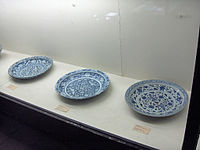Plate (dishware)


A plate is a type of dishware, a broad, concave, but mainly flat vessel on which food is served. They can also be used for ceremonial or decorative purposes.
Design
Materials
Plates are commonly made from ceramic materials such as bone china, porcelain and stoneware as well as other materials like plastic or glass; occasionally, wood or carved stone is used. Disposable plates are often made from paper. Also melamine resin or tempered glass such as Corelle can be used.
Size
Plates for serving food come in a variety of sizes, from small saucers, to bread and butter butter plates, to dinner plates, to large platters from which food for several people may be distributed at table. Some plates are made as decorative items for display rather than used for food.
Plates as collectibles

The Chinese discovered the process of making porcelain around 600 AD. When trade routes opened to China in the 1300s, porcelain objects, including dinner plates, became must-haves for European nobility. However, it wasn't until 1708 when a German potter in Meissen discovered the Chinese process, that the great European potteries came into being. Many of the world's best known potteries were founded during this period - Royal Saxon in 1710, Wedgwood in 1759, Royal Copenhagen in 1775, and Spode, founded in 1776 in England. Monarchs and royalty continued their traditional practice of collecting and displaying porcelain plates, now made locally, but porcelain was still beyond the means of the average citizen.
The practice of collecting "souvenir" plates was popularized in the 1800s by Patrick Palmer-Thomas, a Dutch-English nobleman who wowed Victorian audiences with his public plate displays. These featured transfer designs commemorating special events or picturesque locales - mainly in blue and white. It was an inexpensive hobby, and the variety of shapes and designs catered to a wide spectrum of collectors. The first limited edition collector's plate 'Behind the Frozen Window' is credited to the Danish company Bing and Grondahl in 1895. Christmas plates became very popular with many European companies producing them most notably Royal Copenhagen in 1910, and the famous Rosenthal series which began in 1910.
In the mid-1900s, European collector's plates arrived in the US. There was immediate interest from gift shops and department stores and from the public. The growth of plate collecting and the number of companies producing them is very much down to the strength of interest in the US. In 1973 The Bradford Exchange was founded by J. Roderick MacArthur. The company helped organize the collectors' market and they even opened a trading floor for the buying and selling of collectors' plates.[citation needed]
